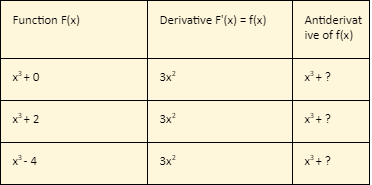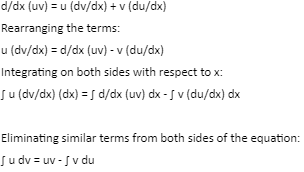Finding the region’s area under the curve is known as integration. One can accomplish integration by drawing as many little rectangles as possible to cover the area and adding them together. The sum of all quantities approaches a limit equal to the integration of some special functions under the curve.
The process of obtaining a function’s antiderivative is known as integration. It is the definite integration if a function is integrable and integral over the domain is finite, with the bounds defined.
If
d/dx(F(x) = f(x)
then
∫ f(x) dx = f(x) + c.
The above are indefinite integrals. For example, let f(x) = x3 be a function. The derivative of expression f(x) is f’(x) = 3×2 and the antiderivative of 3×2 is f(x) = x3

The derivatives of F(x) = f(x) are thus unique, while the anti-derivatives of f(x) are not. The anti-derivative of f(x) is a set of functions with unlimited members.
Because the derivative of any real constant C is zero, we can write it as cos x. dx = sin x + C, there are infinite integrals of this function. The integration rule is to take a collection of real numbers and add an arbitrary constant C to get the conclusion.
If
dx =f(x)
then we write
y=∫f(x)dx
which is read as “Integral of f with respect to x.”
Integration: An Inverse Process of Differentiation
We are given a function’s derivative and asked to discover its primitive or the original function. Anti-differentiation or integration is the term for this type of process. When given a function’s derivative, determining the original function is integration.
The integrals and derivatives are opposites of each other. Take the function f(x)=sin x. F(x) = cos x is the derivative of f(x). The function cos x is known as the derived function of sin x. Sin x is the antiderivative of cos x and vice versa.
Integration by Parts
Integration by parts is a technique or method for combining the output of two or more functions. f(x) and g(x), the two functions to be integrated, are of the form f(x).g (x). As a result, it’s referred to as a product rule of integration.
We choose f(x) because its derivative formula exists, while we select g(x) due to the existence of an integral for it.
∫f(x).g(x).dx=f(x)∫g(x).dx − ∫(f′(x)∫g(x).dx).dx + C.
Integration by Parts Formula Derivation
The formula for the respective derivative of the product of two identical or different functions can prove integration by parts. The derivative of the product of the two functions f(x) and g(x) equals the sum of the first function’s derivatives multiplied by the second function and the derivative of the second function multiplied by the first function.
Let us use the product rule of differentiation to derive the integration by parts formula. Consider the following two functions: you and v. Let y be their product, i.e.:
y = uv
Using the product differentiation rule, we get:

Thus, we drive the integration by parts formula.
There are two parts of the formula in the integration by parts method, and we can see the derivative of the first function f(x) in the second part and the integral of the second function g(x) in both parts. For clarity, we commonly abbreviate these functions as ‘u’ and ‘v,’ respectively.
Using the notation of ‘u’ and ‘v,’ the integration of the uv formula is:
∫ u dv = uv – ∫ v du.
Integration by Parts Applications
We can use the formula derived above for functions or expressions with no integration formulas. Here, we will incorporate the parts-integration formula and derive the integral. There are no integral answers for logarithmic and inverse trigonometric functions. Let us try to solve and find the log x and tan-1x integration.
Integration of Logarithmic Function

Integration of Inverse Trigonometric Function

Conclusion
Integration is a mathematical technique to calculate the area under a curve. There are multiple methods for integration, of which we explore integration by parts in this article. Here, we derive its integration by parts formula and also understand its applications.
 Profile
Profile Settings
Settings Refer your friends
Refer your friends Sign out
Sign out






